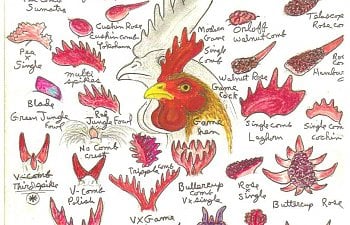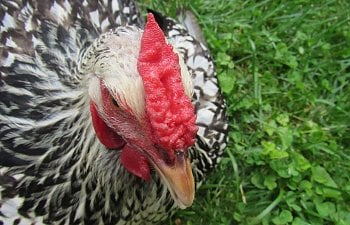All About Combs
Anatomy and Function
History, Food and Medicine
Common Problems
Genetics and Standards
The 9 Comb Types
Anatomy and Function
Anatomy and Function
History, Food and Medicine
Common Problems
Genetics and Standards
The 9 Comb Types
Anatomy and Function
Big, small, rounded, straight, wobbly, pointy, jagged... All chickens have a comb, but all combs are not the same.
Characteristics
The comb is the fleshy growth on top of a chicken's head.
Combs vary in size, shape and color based on the age, sex, and breed of a bird. Chicks will begin to grow a comb within the first few weeks after hatching. Both roosters and hens have combs, but the male's comb is usually larger and brighter than the female's. Because of this, many chicken owners watch their growing chicks carefully since comb growth is one way to determine whether a chick is a pullet or a cockerel.
The breed of a chicken determines the shape and color of the bird's comb. The American Poultry Association recognizes nine different kinds of combs, excluding the carnation (or king's) comb from the following list.
| Name | Description | Example (Male) | (Female) |
| Single | The single comb is probably the most widely-recognized type of chicken comb in the United States, as it appears both on a large number of U.S. breeds and also in cartoons and artwork featuring chickens. The single comb is attached to the chicken's skull in a straight line from the beginning of the beak to the back of the head. It features a series of 5-6 fleshy ridges called points from the front to the center and a thicker potion called the blade in the back. Its texture is smooth and soft. While most single combs are rigidly upright, in some breeds, the comb will flop over to hang on one side of the chicken's head. This is often more typical of hens. | ||
| Carnation (or King's) | The carnation, or king's, comb is unique to the Penedesenca, a chicken breed from Spain. This unusual single comb has several lobes in the rear. The Spanish call this comb cresta en clavel (carnation comb) or cresta del rei (comb of the king). | ||
| Buttercup | Like the single comb, the buttercup comb features points from front to back. However, the buttercup comb is shaped like a crown, with a single leading point at the top of the beak and two ridges of points forming an almost circular, cuplike pattern on the chicken's head. This comb is typical of the Sicilian Buttercup breed. | ||
| Pea | The pea comb is a medium-size comb. It features three ridges running lengthwise from the top of the beak to the top of the head, with the middle ridge a bit higher than the others. Araucanas, Ameraucanas, Aseels, Brahmas, Buckeyes, Cornish, Sumatras and Shamo all have pea combs. | ||
| Cushion | |||
| Strawberry | The strawberry comb is similar in size and shape to the cushion comb. Unlike the cushion comb, however, a strawberry comb has a bumpy, rough surface, similar to the outer texture of a strawberry fruit. Chickens with strawberry combs include Malays and Yokohamas. | ||
| Rose | The rose comb is a fleshy, solid, tube-shaped comb that extends from the top of the beak to the back of the head, ending in a pointed spike. The front two-thirds of this comb is covered in small, round bumps. Dominiques, Hamburgs, Red Caps, Sebrights, and Wyandottes have a rose comb. In several breeds, like Wyandottes, the spiked portion of the comb remains close to the head. There are also "Rose Comb" breeds of Leghorns, Black and White Minorcas, Rhode Island Reds and Rhode Island Whites. | ||
Silkie | The silkie comb is an almost round, somewhat lumpy comb. Its width is usually greater than its length. It is covered with small, horizontal corrugations, with a narrow indentation crossing the comb perpendicularly near the chicken's beak. Sometimes a silkie comb will have two or three rear points. As the breeds of chicken displaying a silkie comb also have feathery crests on their heads, the points will usually be hidden. Genetically, the silkie comb is said to be a second type of rose comb. It was first developed from a rose comb bird crossed with a bird bred from a single comb x rose comb pair. Not surprisingly, some Silkie chickens sport silkie combs. | ||
| Walnut | The walnut comb is a medium-sized, solid comb. It gets its name from the characteristic furrowing on its surface, similar to the outer appearance of a walnut shell. The walnut comb was genetically derived from two dominant alleles for the rose and pea combs. Walnut combs are also typical of Silkie chickens. | ||
| V-Shaped | The V-shaped comb consists of two thick points extending to the left and the right, perpendicularly from a singular base at the top of a chicken's beak. Breeds with V-shaped combs include Crevecoeurs, Houdans, La Flèche, Polish, and Sultans. Other names for the V-shaped comb are the "V comb," the "horn comb," and the "antler comb." | ||
The cushion comb is round, small and solid, with no points or ridges. Starting at the upper portion of the beak, it extends a short way up the chicken's head.
Chanteclers have cushion combs.[/td]
An amazing diversity of unique comb shapes not recognized by the APA are produced when birds with different comb types are bred together.
 This artwork, by Ross Simpson, shows many of the possibilities.
This artwork, by Ross Simpson, shows many of the possibilities.Function
Scientists suggest that a chicken's comb has two important functions. The primary function is to help keep a chicken cool in hot weather, as chickens can't pant like other animals (such as dogs) are able to do. Blood circulates in dense networks of tiny blood vessels and capillaries from the chicken's comb to its wattles. This gives the comb its deep red color and allows the blood to be cooled by the air before traveling to other parts of the bird's body.
The secondary function of the comb is to help a chicken attract a mate. A large, bright-colored comb is a sign of health and vitality. Often, in the pecking order of a flock, the bird with the biggest, brightest comb becomes the "alpha" rooster or hen. "Alpha" roosters are able to mate with all the hens in a flock, ensuring that strong, healthy genes pass on to the next generation. Scientists have studied the correlation between comb size and color and levels of testosterone in chickens. In a flock made up of hens alone, the "alpha" hen -- often the most aggressive -- may grow a larger, brighter comb and even begin to crow.
Comb color also indicates sexual maturity in chickens. People who raise chickens for eggs watch their pullets' developing combs. When the comb reaches a bright red or pink color, the pullet is probably ready to begin laying eggs.
For more information and further reading...
Anderson, Dave. "The Chicken's Comb." Backyard Poultry Magazine. Feb.-Mar. 2008.
Percy, Pam. The Field Guide to Chickens. Saint Paul, MN: Voyageur Press, 2006.
University of Illinois Extension. "Combs - Incubation and Embryology." <http://www.urbanext.uiuc.edu/eggs/res11-combs.html>. 23 August 2008.
Vollmerhaus, B., Reese, S. and Roos, H. "Vascularization of the Fleshy Comb in the Domestic Chicken." Anatomia, Histologia, Embryologia. Volume 34, Supplement 1. December 2005. Blackwell Publishing.[/FONT]

